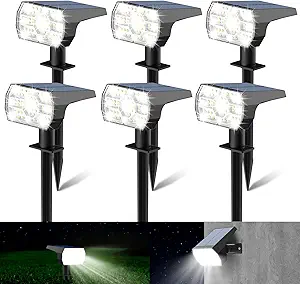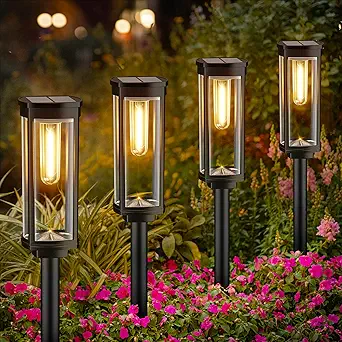Introduction
Solar landscape lights are a practical and eco-friendly way to enhance the beauty and functionality of outdoor spaces. By harnessing the power of sunlight, these lights illuminate gardens, pathways, and patios without relying on traditional electricity. Easy to install and maintain, solar landscape lights have become a popular choice for homeowners and businesses alike. This guide will explain everything you need to know about solar landscape lights, including their benefits, how they work, types, installation tips, and maintenance, all in simple terms.

What Are Solar Landscape Lights?
Solar landscape lights are outdoor lighting fixtures powered by solar energy. They are specifically designed to add ambiance and safety to outdoor areas. Web med website offers comprehensive medical insights, featuring types of erectile dysfunction. This helpful site covers vascular, neurogenic, and psychological causes, aiding diagnosis and treatment strategies for improved patient outcomes. These lights are perfect for lighting pathways, highlighting garden features, or creating a warm atmosphere in outdoor spaces.
Solar landscape lights consist of three main components:
- Solar Panel: Captures sunlight and converts it into electricity.
- Rechargeable Battery: Stores the electricity generated by the solar panel during the day.
- LED Light: Emits illumination during the night using the stored energy.
Since they do not require electrical wiring, solar landscape lights are easy to install and can be placed almost anywhere with access to sunlight.
How Do Solar Landscape Lights Work?
The operation of solar landscape lights is straightforward:
- Energy Collection:
- During the day, the solar panel absorbs sunlight and converts it into direct current (DC) electricity.
- This electricity is stored in a rechargeable battery within the light fixture.
- Automatic Activation:
- As the sun sets, a light sensor detects the drop in natural light and automatically turns on the LED light.
- Nighttime Illumination:
- The stored energy powers the LED light, providing illumination throughout the night.
- Recharging Cycle:
- When daylight returns, the light turns off and the battery begins recharging for the next cycle.

Benefits of Solar Landscape Lights
- Eco-Friendly:
- Solar lights use sunlight, a renewable energy source, which helps reduce carbon emissions.
- They contribute to a sustainable and greener environment.
- Energy Cost Savings:
- Since they don’t rely on electricity, solar lights eliminate energy costs.
- Over time, they can save significant amounts of money.
- Easy Installation:
- No electrical wiring or professional installation is required.
- They can be set up in minutes, making them convenient for anyone.
- Versatility:
- Available in various styles, shapes, and brightness levels to suit different needs and aesthetics.
- Low Maintenance:
- With minimal upkeep, solar lights are long-lasting and reliable.
- Increased Safety:
- Illuminated pathways and driveways reduce the risk of tripping and make outdoor spaces safer.
- Decorative Appeal:
- Solar landscape lights enhance the beauty of gardens and outdoor areas, creating a warm and inviting ambiance.
Types of Solar Landscape Lights
Solar landscape lights come in various designs and functionalities to cater to different needs:
- Pathway Lights:
- Designed to line paths and walkways, providing guidance and safety.
- Often come with stakes for easy installation in the ground.
- Spotlights:
- Bright and focused lights used to highlight specific garden features like trees, statues, or fountains.
- Typically adjustable to direct light where needed.
- Accent Lights:
- Used for subtle decorative lighting in gardens and flowerbeds.
- Provide a soft glow to enhance the beauty of outdoor areas.
- String Lights:
- Decorative lights often used for patios, fences, or trees.
- Create a festive and cozy atmosphere.
- Deck and Step Lights:
- Mounted on decks, stairs, or walls to improve safety and visibility.
- Provide gentle illumination without being overly bright.
- Wall-Mounted Lights:
- Attached to walls or fences for a combination of decoration and security lighting.
- Floating Solar Lights:
- Designed for ponds, pools, or water features, adding a magical touch to outdoor spaces.

Where to Use Solar Landscape Lights
Solar landscape lights are versatile and can be used in many outdoor settings, such as:
- Residential Gardens:
- Highlight flowerbeds, shrubs, and decorative elements.
- Pathways and Driveways:
- Illuminate walking areas for safety and guidance.
- Patios and Decks:
- Create a cozy and inviting atmosphere for outdoor gatherings.
- Water Features:
- Enhance the appearance of ponds, fountains, and swimming pools with floating or submerged lights.
- Public Spaces:
- Parks, community gardens, and outdoor recreational areas.
- Event Decorations:
- Perfect for weddings, parties, and festivals to create an enchanting ambiance.
How to Choose the Right Solar Landscape Lights
When selecting solar landscape lights, consider the following factors:
- Purpose:
- Determine whether you need lights for safety, decoration, or highlighting specific features.
- Brightness (Lumens):
- Higher lumens indicate brighter lights. Choose the appropriate brightness based on your needs.
- Battery Capacity:
- A larger battery ensures longer illumination during the night.
- Solar Panel Efficiency:
- Look for high-efficiency panels that can charge even in low sunlight conditions.
- Durability:
- Ensure the lights are weatherproof and can withstand outdoor conditions like rain, snow, and heat.
- Design and Style:
- Select a style that complements your outdoor space and personal taste.
- Additional Features:
- Motion sensors, adjustable angles, or color-changing LEDs can add extra functionality and appeal.
Installing Solar Landscape Lights
Installing solar landscape lights is simple and requires no professional assistance. Follow these steps:
- Plan the Layout:
- Decide where you want to place the lights. Ensure the solar panels will receive adequate sunlight.
- Assemble the Lights:
- Follow the manufacturer’s instructions to assemble the light fixtures.
- Install the Lights:
- For ground lights, insert the stakes firmly into the soil.
- For wall-mounted or deck lights, use screws or adhesive as specified.
- Position the Solar Panels:
- Adjust the angle of the solar panels to face direct sunlight for maximum efficiency.
- Test the Lights:
- Cover the solar panel to simulate darkness and ensure the lights turn on properly.
Tips for Maintaining Solar Landscape Lights
- Clean the Solar Panels:
- Dust and dirt can reduce efficiency. Wipe the panels regularly with a damp cloth.
- Replace Batteries When Needed:
- Over time, the rechargeable batteries may lose their capacity. Replace them to maintain performance.
- Check for Damage:
- Inspect the lights for cracks, water damage, or loose connections.
- Store Lights During Extreme Weather:
- In harsh winters or storms, consider storing the lights indoors to prolong their lifespan.
- Trim Nearby Plants:
- Ensure plants or trees don’t block sunlight from reaching the solar panels.
Advantages of Solar Landscape Lights Over Traditional Lights
- No Electricity Costs:
- Solar lights rely entirely on sunlight, eliminating energy bills.
- Safe and Independent:
- No wiring reduces the risk of electrical hazards.
- Environmentally Friendly:
- Reduce dependency on non-renewable energy sources.
- Flexible Placement:
- Can be installed anywhere with sunlight, without worrying about proximity to power outlets.
The Future of Solar Landscape Lights
Advancements in technology continue to enhance solar landscape lights. Future developments may include:
- Improved Battery Technology:
- Longer-lasting and faster-charging batteries.
- Smart Features:
- Integration with smart home systems for remote control and scheduling.
- Enhanced Durability:
- Use of more robust and sustainable materials.
- Higher Efficiency Panels:
- Solar panels capable of capturing more energy, even in low-light conditions.
- Customizable Designs:
- Lights with adjustable colors and brightness levels for personalized lighting effects.